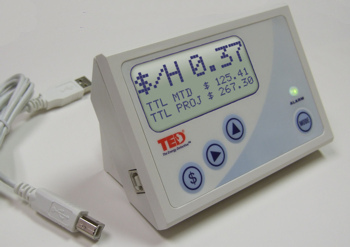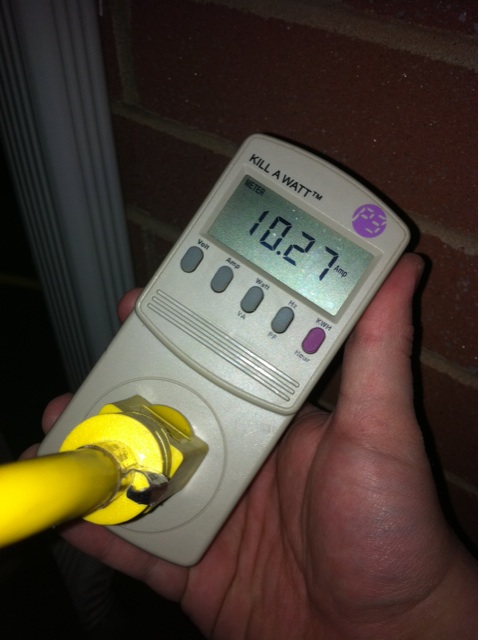|
Home Energy Monitor
A home energy monitor provides feedback on electrical energy use. Devices may also display cost of energy used, and estimates of greenhouse gas emissions. Various studies have shown a reduction in home energy use of 4-15% through use of home energy display. Electricity use may be measured with an inductive clamp placed around the electric main, via the electric meter (either through an optical port, or by sensing the meters actions), by communicating with a smart meter, or by direct connection to the electrical system. The display portion may be remote from the measurement, communicating with the sensor using a cable, network, power line communications, or using radio. Online displays are also available which allow the user to use an internet connected display to show near real-time consumption. A means to reduce household energy consumption is to provide real-time feedback to homeowners so they can change their energy use. In 2010, UK based Current Cost announced a partne ... [...More Info...] [...Related Items...] OR: [Wikipedia] [Google] [Baidu] |
TED Model 1001
TED may refer to: Economics and finance * TED spread between U.S. Treasuries and Eurodollar Education * ''Türk Eğitim Derneği'', the Turkish Education Association ** TED Ankara College Foundation Schools, Turkey ** Transvaal Education Department (TED) Entertainment and media * TED (conference) (Technology, Entertainment, and Design) * ''Tenders Electronic Daily'', a journal on government procurement in the European Union * Turner Field (The Ted), of the Atlanta Braves until 2017 Technology and computing * MOS Technology TED, an integrated circuit * TED Notepad, a freeware portable plain-text editor * Television Electronic Disc, an early Telefunken video disc * Transferred electron device or Gunn diode * TransLattice Elastic Database, a NewSQL database Transport * Teddington railway station, London, National Rail station code Other uses * Thyroid eye disease, aka Graves' ophthalmopathy * Tooheys Extra Dry, Australian beer * Turtle excluder device, for letting sea turtles es ... [...More Info...] [...Related Items...] OR: [Wikipedia] [Google] [Baidu] |
AlertMe
AlertMe was a UK smart Tech company that provides energy and home monitoring hardware and services. AlertMe produces hardware and software to enable users to monitor and control their home energy use. In 2015 the company was acquired by British Gas Trading Limited for £65 million. In April 2016 the limited company was renamed to Centrica Connected Home Limited. AlertMe uses Non Intrusive Load Monitoring to extrapolate trends from customer data, which is then used to make energy saving recommendations. Hardware The AlertMe platform is based on a home hub that connects to cloud servers provided by Amazon Web Services Amazon Web Services, Inc. (AWS) is a subsidiary of Amazon that provides on-demand cloud computing platforms and APIs to individuals, companies, and governments, on a metered pay-as-you-go basis. These cloud computing web services provide ... via the home broadband router. The hub communicates via wireless to devices in the home, both AlertMe devices ... [...More Info...] [...Related Items...] OR: [Wikipedia] [Google] [Baidu] |
Wattmeter
The wattmeter is an instrument for measuring the electric active power (or the average of the rate of flow of electrical energy) in watts of any given circuit. Electromagnetic wattmeters are used for measurement of utility frequency and audio frequency power; other types are required for radio frequency measurements. A wattmeter reads the average value of the product ''v(t)i(t) = p(t)'', where ''v(t)'' is the voltage with positive reference polarity at the ± terminal with respect to the other terminal of the potential coil, and ''i(t)'' is the current with reference direction flowing into the ± terminal of the current coil. The wattmeter reads ''P = (1/T) ∫0T v(t)i(t) dt'', which in sinusoidal steady-state reduces to ''V''rms ''I''rms cos(φ), where ''T'' is the period of ''p(t)'' and φ is the angle by which the current lags the voltage. History On 14 August 1888, Oliver B. Shallenberge patented a watt-hour meter. The Hungarian Ottó Bláthy patented his AC wattmeter. In ... [...More Info...] [...Related Items...] OR: [Wikipedia] [Google] [Baidu] |
Smart Meter
A smart meter is an electronic device that records information such as consumption of electric energy, voltage levels, current, and power factor. Smart meters communicate the information to the consumer for greater clarity of consumption behavior, and electricity suppliers for system monitoring and customer billing. Smart meters typically record energy near real-time, and report regularly, short intervals throughout the day. Smart meters enable two-way communication between the meter and the central system. Such an advanced metering infrastructure (AMI) differs from automatic meter reading (AMR) in that it enables two-way communication between the meter and the supplier. Communications from the meter to the network may be wireless, or via fixed wired connections such as power line carrier (PLC). Wireless communication options in common use include cellular communications, Wi-Fi (readily available), wireless ad hoc networks over Wi-Fi, wireless mesh networks, low power l ... [...More Info...] [...Related Items...] OR: [Wikipedia] [Google] [Baidu] |
Nonintrusive Load Monitoring
Nonintrusive load monitoring (NILM), or nonintrusive appliance load monitoring (NIALM), is a process for analyzing changes in the voltage and current going into a house and deducing what appliances are used in the house as well as their individual energy consumption. Electric meters with NILM technology are used by utility companies to survey the specific uses of electric power in different homes. NILM is considered a low-cost alternative to attaching individual monitors on each appliance. It does, however, present privacy concerns. Background and theory Nonintrusive load monitoring was invented by George W. Hart, Ed Kern and Fred Schweppe of MIT in the early 1980s with funding from the Electric Power Research Institute. The basic process is described in . As shown in figure 1 from the patent, a digital AC monitor is attached to the single-phase power going into a residence. Changes in the voltage and current are measured (i.e. admittance measurement unit), normalized (scaler) a ... [...More Info...] [...Related Items...] OR: [Wikipedia] [Google] [Baidu] |
Kill A Watt
The Kill A Watt (a pun on ''kilowatt'') is an electricity usage monitor manufactured by Prodigit Electronics and sold by P3 International. It measures the energy used by devices plugged directly into the meter, as opposed to in-home energy use displays, which display the energy used by an entire household. The LCD shows voltage; current; true, reactive, and apparent power; power factor (for sinusoidal waveform); energy consumed in kWh; and hours connected. Some models display estimated cost. Having a NEMA 5-15 plug and receptacle, and rated for 115 VAC (maximum 125 VAC), the Kill A Watt is sold for the North American market. The unit is manufactured by the Taiwanese company Prodigit, which also makes 230 VAC models of similar appearance and functionality for European Schuko, U.K. BS 1363 and Australian AS 3112 receptacles, and a model compatible with 100 VAC for the Japanese market (2022-04, marketed there as the Watt Checker ��ットチェッカーPlus ... [...More Info...] [...Related Items...] OR: [Wikipedia] [Google] [Baidu] |
Home Automation
Home automation or domotics is building automation for a home, called a smart home or smart house. A home automation system will monitor and/or control home attributes such as lighting, climate, entertainment systems, and appliances. It may also include home security such as access control and alarm systems. When connected with the Internet, home devices are an important constituent of the Internet of Things ("IoT"). A home automation system typically connects controlled devices to a central smart home hub (sometimes called a " gateway"). The user interface for control of the system uses either wall-mounted terminals, tablet or desktop computers, a mobile phone application, or a Web interface that may also be accessible off-site through the Internet. While there are many competing vendors, there are increasing efforts towards open source systems. However, there are issues with the current state of home automation including a lack of standardized security measures and d ... [...More Info...] [...Related Items...] OR: [Wikipedia] [Google] [Baidu] |
Energy Conservation
Energy conservation is the effort to reduce wasteful energy consumption by using fewer energy services. This can be done by using energy more effectively (using less energy for continuous service) or changing one's behavior to use less service (for example, by driving less). Energy conservation can be achieved through energy efficiency, which has a number of advantages, including a reduction in greenhouse gas emissions, a smaller carbon footprint, and cost, water, and energy savings. Energy conservation is an essential factor in building design and construction. It has increased in importance since the 1970s, as 40% of energy use in the U.S. is in buildings. Recently, concern over the effects of climate change and global warming has emphasized the importance of energy conservation. Energy can only be transformed from one form to another, such as when heat energy is converted into vehicle motive power or when water flow's kinetic energy is converted into electricity in hydroelectr ... [...More Info...] [...Related Items...] OR: [Wikipedia] [Google] [Baidu] |
Energy Management Software
Energy Management Software (EMS) is a general term and category referring to a variety of energy-related software applications which may provide utility bill tracking, real-time metering, building HVAC and lighting control systems, building simulation and modeling, carbon and sustainability reporting, IT equipment management, demand response, and/or energy audits. Managing energy can require a system of systems approach. Energy management software often provides tools for reducing energy costs and consumption for buildings, communities or industries. EMS collects energy data and uses it for three main purposes: Reporting, Monitoring and Engagement. Reporting may include verification of energy data, benchmarking, and setting high-level energy use reduction targets. Monitoring may include trend analysis and tracking energy consumption to identify cost-saving opportunities. Engagement can mean real-time responses (automated or manual), or the initiation of a dialogue between occupants ... [...More Info...] [...Related Items...] OR: [Wikipedia] [Google] [Baidu] |
Victoria (Australia)
Victoria is a state in southeastern Australia. It is the second-smallest state with a land area of , the second most populated state (after New South Wales) with a population of over 6.5 million, and the most densely populated state in Australia (28 per km2). Victoria is bordered by New South Wales to the north and South Australia to the west, and is bounded by the Bass Strait to the south (with the exception of a small land border with Tasmania located along Boundary Islet), the Great Australian Bight portion of the Southern Ocean to the southwest, and the Tasman Sea (a marginal sea of the South Pacific Ocean) to the southeast. The state encompasses a range of climates and geographical features from its temperate coastal and central regions to the Victorian Alps in the northeast and the semi-arid north-west. The majority of the Victorian population is concentrated in the central-south area surrounding Port Phillip Bay, and in particular within the me ... [...More Info...] [...Related Items...] OR: [Wikipedia] [Google] [Baidu] |






